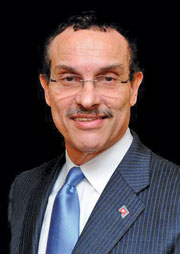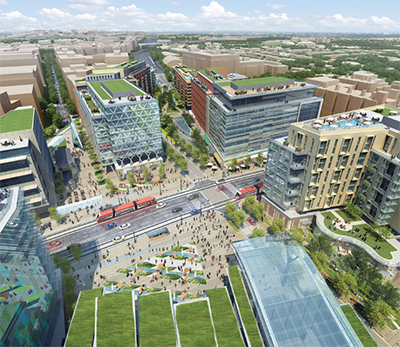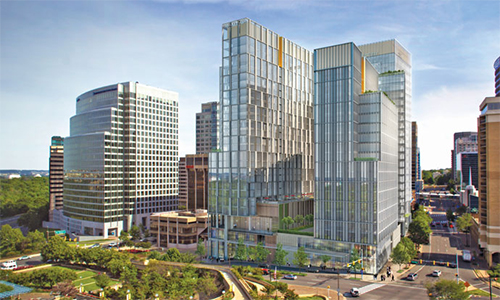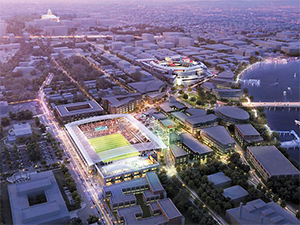Geographically speaking, you can’t get more Mid-Atlantic than the nation’s capital. Washington, DC’s economic development momentum, however, is anything but middle of the road. Pick your favorite indicator.
Last year Richard Florida’s “The Rise of the Creative Class Revisited,” found that Washington landed at No. 9 overall and No. 3 for talent in his Creativity Index. Forbes called the city the No. 1 tech hot spot in the nation. The economic-research firm POLICOM said DC’s is the strongest economy in the United States.
It’s the No. 1 city in the country for LEED-certified buildings (thanks in no small part to federal goals in that regard). Careerbuilder.com says it’s the best city in the nation for recent college graduates. The Ewing Marion Kauffman Foundation named DC first in the US for attracting and producing entrepreneurial founders of companies. The Urban Land Institute ranked DC second in the nation for real estate investment; and Harvard presented its Bright Idea award to the city for its One City•One Hire jobs program.

Vincent Gray, mayor of
Washington, D.C.
Looking to reach consumers? Pitney Bowes Software’s new Metro Magnets Index, released in Nov. 2012, said Houston, Atlanta and the Washington D.C. metropolitan areas are projected to add the most households in absolute terms over the next five years, with D.C. adding 84,000.
Looking for responsible fiscal behavior from those households? According to LendingTree, you can’t get much more stable than DC. Using a weighted average of credit score, loan-to-value ratio and overall lendability of mortgage-seekers in each state for the second quarter of 2013, the online source for competitive loan offers said the borrower health of Washington, D.C., was the best of any state or district in the nation, with an average credit score of 689.
The fiscal common sense extends to the city. Moody’s Investor Service this  summer upgraded its outlook for the District’s general obligation bonds to “stable” from the “negative” outlook the agency issued in September 2011.
summer upgraded its outlook for the District’s general obligation bonds to “stable” from the “negative” outlook the agency issued in September 2011.
Vincent Gray, mayor of Washington, D.C., understands the importance of fiscal health to the health of his city.
Developer Akridge hopes to start construction in 2014 on Burnham Place at Union Station, a mixed-use vision that encompasses 3 million sq. ft. (sq. m.) of office, residential, hotel and retail space, as well as renovation to Union Station itself. The city in 2011 created the Union Station North Zone District, which allowed Akridge to start design work.
Image courtesy of Akridge
“That’s one of the things I said we’d focus on when I ran,” he says of his successful campaign for mayor in 2010. “We were not down to zero, but we were in terms of flexibility. Money was committed to a congressionally required reserve fund, and to our bond escrow fund. We had no flexible dollars when I came into office. We’re now at $1.5 billion, and one of the healthiest fund balances in the nation.” He calls the ratings agencies’ upgrades a “hugely powerful statement, a lot of it because of our commitment to fiscal rigor, and frankly having made a commitment to a debt ceiling of 12 percent. That is a subject of debate by some, but for our purposes, we are better served by having a debt ceiling and adhering to it.”
![]() We’ve been working hard to
We’ve been working hard to
become much more competitive, recognizing that Maryland and Virginia
have been for some time. ![]()
— Vincent Gray, mayor, Washington, DC
Gray also understands the importance of economic development to that fiscal health. It’s why he and Deputy Mayor Victor Hoskins last November launched a five-year strategy that includes “six transformative visions” for the DC economy:
- Create the most business-friendly economy in the nation;
- Grow the largest technology center on the East Coast;
- Be the nation’s destination of choice;
- End retail leakage;
- Develop a best-in-class global medical center;
- Become the top North American destination for foreign investors, businesses and tourists.
“The technology concentration is really a headliner for us,” he says in an interview. Defined historically as a federal government city, DC is no longer completely economically dependent on its relationship to that government, he says. And the specter of sequestration, ironically, only provides further impetus to broaden its economy.
Eye Openers
Gray says hospitality, tourism and healthcare services have long been part of that economic landscape, but technology “had really been essentially non-existent. Our goal is to be the Silicon Valley of the East, and we’ve been working hard to become much more competitive, recognizing that Maryland and Virginia have been for some time.”
Helping achieve that goal are such deals as Google’s recent doubling of its space a block from Union Station, where it signed a lease for 55,000 sq. ft. (5,110 sq. m.). Client server software firm CSS.Net recently relocated to the city from Nebraska. Fosterly, a technology entrepreneur resource, recently located to DC as well. Steve Case’s venture capital firm Revolution is based in DC, and IBM has established its sixth advanced analytic center there.
Among the city’s efforts is an incubator organization called 1776 that had over 100 start-ups present on the day it opened this summer. The city also owns part of a former federal installation, the St. Elizabeths complex established in the mid-19th century and long considered the best mental health facility in the nation. It ceased to be under federal control in the 1980s and was taken over by the city. While the west side of the campus is still federally owned, the District owns more than 180 acres on the east side, and plans to do big things with it.
“We’re using it as a center for technology development,” says Gray, noting that the city already has welcomed SmartBIM (a building design firm) and renowned French urban lighting and traffic management firm Citelum. Gray says his team is close to finalizing a deal with another tech company some may have heard of: Microsoft.
“They have no innovation centers outside of Redmond, Washington, and we’re very close to finalizing a deal to bring an innovation center here,” he says. “That is an eyebrow raiser and an eye opener. For them to come here, especially in an era that has been economically and socially challenging, transcends any statement I can make.”
But that good federal relationship still helps. The US Coast Guard just built a new 2.1-million-sq.-ft. (195,090-sq.-m.) headquarters on the western side, home to 3,700 employees. “As is always the case with federal installations, you’ll have contractors that will follow behind,” he says, “and we’re working to create a place for them on the east side.
“When I first got elected, I had a meeting with the President,” Gray says, “and one thing I said that would be most important would be relationships with the leadership of his agencies. That’s where we’ve really worked hard during these past two years.” It helps that the current administrator of the General Services Administration, looked to as the federal landlord, used to be the city administrator for the District. Gray says examples of collaboration include the relocation of Walter Reed Hospital, which means part of the former site will now be redeveloped as mixed use. The city has worked closely with the EPA on its model sustainability plan, and its work with the Small Business Administration has led to funds for the city’s export/import program, including trade efforts with China and South Africa.
Infrastructure That Matters
The city also just completed a stage in the process to bring 11 different area universities on board at St. Elizabeths, all of which are interested in being a potential academic partner for Microsoft and other firms landing in the redeveloped area. Gray says a public high school is being rebuilt with $125 million in city dollars just three blocks away, and it will open for the 2014 school year with a focus on STEM education. The educational assets may look like amenities, but are really essentials.

Arlington Gets Vertical
T he transit-oriented vibe is strong throughout Greater Washington, but especially pronounced in Arlington County. In July, the Arlington County Board approved phases four and five of Vornado’s Metropolitan Park project to redevelop an existing warehouse site to a single residential and retail high-rise in Pentagon City. Last fall, the board approved the first major redevelopment project under the Crystal City Sector Plan, which involves the demolition of a block-long, outdated and vacant office building in the heart of Crystal City and replace it with a Class-A, 24-story office building with ground floor retail and a half-acre interim park. Last summer, yet another project received the go-ahead in Rosslyn, as developer JBG received county approval for the replacement of two old office buildings with three new buildings (pictured) that will contain nearly 1 million sq. ft. (92,900 sq. m.) of prime office and retail space, hotel rooms and residential units when fully built out as Rosslyn Gateway.
“One of the problems we have is that only 30 percent of our work force lives in the District,” he says. “We are one of the few jurisdictions where we cannot tax income at its source — people pay taxes where they live.” So the city aims to increase that percentage, “and the way you do that is increase the education.”
Gray emphasizes the inextricable ties between education and work-force development, “especially if you want to have an indigenous work force. Any companies thinking about locating here obviously, as they locate people, will ask, ‘Do they have a school system people can feel comfortable putting their kids in?’ ”
Since 2008, the District has invested nearly $1.5 billion in more than 60 schools. Approximately 6.5 million sq. ft. (603,850 sq. m.) of new and renovated space has been completed since 2001.
Gray says there’s still a long way to go with education reform, but test results revealed this summer showed achievement progress in every grade but one. “We take that to mean the systemic changes we’ve been making are starting to take hold now. From the perspective of economic development, it’s a powerful argument to make to those who would think about coming here.”
A Real Kick
Gray sees the city’s emphasis on sustainability and walkable, transit-oriented development as a major tool in that effort. That includes the reintroduction of streetcars.
“They existed four or five decades ago, and were eliminated,” he says. “We’ll be opening our first streetcar line, on the way to a 37-mile system, this year.”
In NoMA — one of city’s hottest neighborhoods — the city helped to develop a plan to share the cost of a new Metro rail station among property owners, federal and city governments. Development within the Capitol Riverfront includes over 7 million sq. ft. (650,300 sq. m.) of office space and another 8 million sq. ft. (743,200 sq. m.) planned.

![]() The new soccer stadium is the final piece in the
The new soccer stadium is the final piece in the
Anacostia Waterfront Initiative puzzle that, when complete, will create the most vibrant and sustainable
sports-and-retail district in America. ![]()
— Vincent Gray, mayor, Washington, DC
The large-scale redevelopment of the Anacostia Waterfront got a big boost this summer with the signing of a landmark agreement with Major League Soccer’s D.C. United to construct a new stadium in the Buzzard Point area of Southwest, adjacent to the Fort McNair Army base.
The deal anticipates a creative development plan, including a series of land swaps to support the approximately $300-million project and spur additional development without having an impact on the District’s debt cap. Under the provisions of the term sheet, the District anticipates that it will swap District-owned property, including the Frank D. Reeves Center for Municipal Affairs, to assemble the stadium site parcels. The plan calls for Reeves Center tenants as well as District agencies currently in leased space to relocate to a new municipal facility in Anacostia.
“One of the important selling points is, should the construction of the stadium incur cost overruns, that’s on them,” says Gray. The Nationals stadium cost the city $700 million, while this deal will cost it about $175 million. Also, he points out, “this is a creative deal — it doesn’t stop with the stadium.” He sees the rebuilt Reeves center as another development of the sort that can be labeled a catalyst.
Gray doesn’t want to see that momentum slow. The city already offers tech-firm incentives, but he wants to offer more. And he’s convened a task force to look at the city’s regulatory schema. It’s early in the process, he says, but “we’ve discovered you don’t wait until it’s done to roll everything out. I expect before the year is out, we’ll roll out the changes.”
